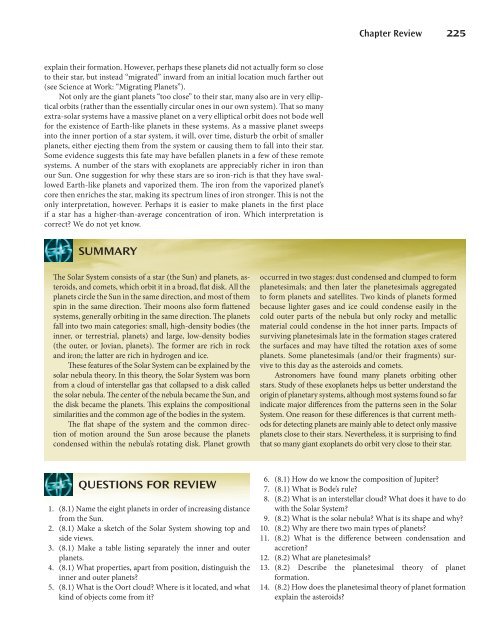Chapter 8
Chapter 8
Chapter 8
Create successful ePaper yourself
Turn your PDF publications into a flip-book with our unique Google optimized e-Paper software.
explain their formation. However, perhaps these planets did not actually form so close<br />
to their star, but instead “migrated” inward from an initial location much farther out<br />
(see Science at Work: “Migrating Planets”).<br />
Not only are the giant planets “too close” to their star, many also are in very elliptical<br />
orbits (rather than the essentially circular ones in our own system). Th at so many<br />
extra-solar systems have a massive planet on a very elliptical orbit does not bode well<br />
for the existence of Earth-like planets in these systems. As a massive planet sweeps<br />
into the inner portion of a star system, it will, over time, disturb the orbit of smaller<br />
planets, either ejecting them from the system or causing them to fall into their star.<br />
Some evidence suggests this fate may have befallen planets in a few of these remote<br />
systems. A number of the stars with exoplanets are appreciably richer in iron than<br />
our Sun. One suggestion for why these stars are so iron-rich is that they have swallowed<br />
Earth-like planets and vaporized them. Th e iron from the vaporized planet’s<br />
core then enriches the star, making its spectrum lines of iron stronger. Th is is not the<br />
only interpretation, however. Perhaps it is easier to make planets in the fi rst place<br />
if a star has a higher-than-average concentration of iron. Which interpretation is<br />
correct? We do not yet know.<br />
SUMMARY<br />
Th e Solar System consists of a star (the Sun) and planets, asteroids,<br />
and comets, which orbit it in a broad, fl at disk. All the<br />
planets circle the Sun in the same direction, and most of them<br />
spin in the same direction. Th eir moons also form fl attened<br />
systems, generally orbiting in the same direction. Th e planets<br />
fall into two main categories: small, high-density bodies (the<br />
inner, or terrestrial, planets) and large, low-density bodies<br />
(the outer, or Jovian, planets). Th e former are rich in rock<br />
and iron; the latter are rich in hydrogen and ice.<br />
Th ese features of the Solar System can be explained by the<br />
solar nebula theory. In this theory, the Solar System was born<br />
from a cloud of interstellar gas that collapsed to a disk called<br />
the solar nebula. Th e center of the nebula became the Sun, and<br />
the disk became the planets. Th is explains the compositional<br />
similarities and the common age of the bodies in the system.<br />
Th e fl at shape of the system and the common direction<br />
of motion around the Sun arose because the planets<br />
condensed within the nebula’s rotating disk. Planet growth<br />
QUESTIONS FOR REVIEW<br />
1. (8.1) Name the eight planets in order of increasing distance<br />
from the Sun.<br />
2. (8.1) Make a sketch of the Solar System showing top and<br />
side views.<br />
3. (8.1) Make a table listing separately the inner and outer<br />
planets.<br />
4. (8.1) What properties, apart from position, distinguish the<br />
inner and outer planets?<br />
5. (8.1) What is the Oort cloud? Where is it located, and what<br />
kind of objects come from it?<br />
<strong>Chapter</strong> Review 225<br />
occurred in two stages: dust condensed and clumped to form<br />
planetesimals; and then later the planetesimals aggregated<br />
to form planets and satellites. Two kinds of planets formed<br />
because lighter gases and ice could condense easily in the<br />
cold outer parts of the nebula but only rocky and metallic<br />
material could condense in the hot inner parts. Impacts of<br />
surviving planetesimals late in the formation stages cratered<br />
the surfaces and may have tilted the rotation axes of some<br />
planets. Some planetesimals (and/or their fragments) survive<br />
to this day as the asteroids and comets.<br />
Astronomers have found many planets orbiting other<br />
stars. Study of these exoplanets helps us better understand the<br />
origin of planetary systems, although most systems found so far<br />
indicate major diff erences from the patterns seen in the Solar<br />
System. One reason for these diff erences is that current methods<br />
for detecting planets are mainly able to detect only massive<br />
planets close to their stars. Nevertheless, it is surprising to fi nd<br />
that so many giant exoplanets do orbit very close to their star.<br />
6. (8.1) How do we know the composition of Jupiter?<br />
7. (8.1) What is Bode’s rule?<br />
8. (8.2) What is an interstellar cloud? What does it have to do<br />
with the Solar System?<br />
9. (8.2) What is the solar nebula? What is its shape and why?<br />
10. (8.2) Why are there two main types of planets?<br />
11. (8.2) What is the diff erence between condensation and<br />
accretion?<br />
12. (8.2) What are planetesimals?<br />
13. (8.2) Describe the planetesimal theory of planet<br />
formation.<br />
14. (8.2) How does the planetesimal theory of planet formation<br />
explain the asteroids?<br />
arn12176_ch08.indd 225 7/30/09 2:14:48 PM

















